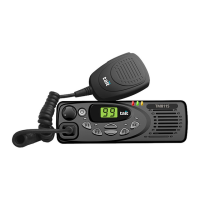TM8100/TM8200 Service Manual Circuit Descriptions 71
© Tait Electronics Limited June 2006
Automatic Gain
Control
The receiver has an AGC circuit to enable it to cover a large signal range.
Most of the circuit functions are implemented in the FPGA. The FPGA
passes the AGC signal to the CODEC IC204 for output from pin 14
(
IDACOUT) and then via IC201 as the signal CDC RX AGC to pin 23 of the
quadrature mixer IC400. As the antenna signal increases, the AGC voltage
decreases.
Channel Filtering The channel filtering is split between the first and third IF stages.
The channel filtering circuit in the first IF stage comprises a pair of two-pole
crystal filters. The first filter has a 3dB bandwidth of 12kHz, and the second
a 3dB bandwidth of 15kHz. Most of the channel filtering, however, is
implemented in the FPGA. When the radio is programmed, the different
filters are selected as assigned by the channel programming. The selectable
filters plus the fixed crystal filters result in the following total IF 3dB
bandwidths:
■ wide channel spacing : 12.6kHz
■ medium channel spacing: 12.0kHz
■ narrow channel spacing : 7.8kHz.
(The FPGA runs from the
DIG SYS CLK signal, which has a frequency of
12.288MHz.) The receiver requires the TCXO calibration to be completed
to ensure that the channel filtering is centred, thereby minimizing
distortion.
Received Signal
Strength Indication
The RSSI is calculated in the FPGA and DSP, and can be passed as an analog
voltage to the internal options interface and the external auxiliary interface.
To obtain an accurate estimate of the RSSI (over the signal level and
frequency), it is necessary to calibrate the AGC characteristic of the receiver
and the front-end gain versus the receive frequency.
Front-End AGC
Control
The receiver has a front-end AGC circuit to enable it to handle large
receiver signals with minimal receiver distortion. This is very important for
the correct operation of the THSD modem (Tait High-Speed Data). It
enables THSD to maintain residual BER of < 10
-4
. The front-end AGC is
controlled by an algorithm which monitors the RSSI and configures the
DAC to turn on the front-end attenuation via the receive pin diode of the
PIN switch.
Noise Blanker (A4,
B1 bands only)
If the frequency band is between 66 and 174MHz, a noise blanker can be
selected to remove common sources of electrical interference such as vehicle
ignition noise. The noise blanker functions by sampling the RF input to the
receiver for impulse noise and momentarily disconnecting the first LO for
the duration of the impulse. The response time of the noise blanker is very
fast (tens of nanoseconds) and is quicker than the time taken for the RF
signal to pass through the front-end hardware, so that the LO is disabled
before the impulse reaches the IF stage where it could cause crystal
filter ring.

